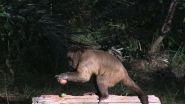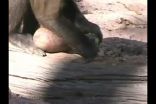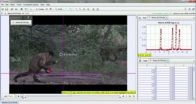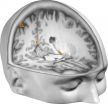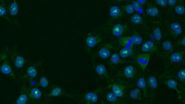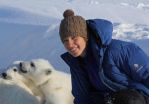Wild bearded capuchin monkeys really know how to crack a nut
2015-04-30
(Press-News.org) When it comes to cracking nuts, wild bearded capuchin monkeys are more skilled than anyone had given them credit for, according to researchers who report new findings in the Cell Press journal Current Biology on April 30.
The monkeys are known to use stone "hammers" to crack nuts. The new study shows that the monkeys are quite careful about the amount of force delivered to those nuts. They adjust the force applied with each strike based on the condition of the nutshell, making it less likely that they'll end up smashing the tasty kernel inside.
"Wild bearded capuchin monkeys dynamically modulate their strikes based on the outcome of the preceding strike while using stone hammers to crack nuts," says Madhur Mangalam of the University of Georgia at Athens. "Until now, this level of dexterity was not suspected of any monkey."
Mangalam's graduate advisor, Dorothy Fragaszy, and her colleagues have studied nut-cracking in wild bearded capuchin monkeys since 2005, when they established the EthoCebus research project. They were especially curious how the monkeys managed to crack such hard nuts. They also wondered whether the monkeys might change their nut-cracking approach with nuts that are softer.
In the new study, the researchers videotaped 14 capuchin moneys cracking nuts. They carefully analyzed the tapes to determine the height and velocity of each and every strike. It typically takes several strikes with a stone to reach the nut inside.
And what they discovered came as quite a surprise.
"It was a 'eureka' moment when we realized that the monkeys modulated the strikes systematically according to the condition of the nut following the preceding strike," Mangalam says.
They had expected the monkeys to maintain the force of their strikes within a certain range, or possibly to increase it until the nuts cracked. It never crossed their minds that the monkeys might show such a sophisticated ability to match their action to the physical state of the nut. But that's exactly what they did.
"Our finding opens our eyes to the fact that non-human primates modulate their actions with a tool to accommodate the rapidly changing requirements of the task, which is a cognitive accomplishment," Mangalam says.
The researchers now plan to examine whether other species make adjustments in tool use on the fly. They'll also explore how this kind of dexterity influences each species' tool-use repertoire.
INFORMATION:
Current Biology, Mangalam et al.: "Wild Bearded Capuchin Monkeys Crack Nuts Dexterously" http://dx.doi.org/10.1016/j.cub.2015.03.035
Current Biology, published by Cell Press, is a bimonthly journal that features papers across all areas of biology. Current Biology strives to foster communication across fields of biology, both by publishing important findings of general interest and through highly accessible front matter for non-specialists. For more information please visit http://www.cell.com/current-biology. To receive media alerts for Current Biology or other Cell Press journals, contact press@cell.com.
ELSE PRESS RELEASES FROM THIS DATE:
2015-04-30
Bats are masters of flight in the night sky, capable of steep nosedives and sharp turns that put our best aircraft to shame. Although the role of echolocation in bats' impressive midair maneuvering has been extensively studied, the contribution of touch has been largely overlooked. A study published April 30 in Cell Reports shows, for the first time, that a unique array of sensory receptors in the wing provides feedback to a bat during flight. The findings also suggest that neurons in the bat brain respond to incoming airflow and touch signals, triggering rapid adjustments ...
2015-04-30
Neuroscientists have perfected a chemical-genetic remote control for brain circuitry and behavior. This evolving technology can now sequentially switch the same neurons - and the behaviors they mediate - on-and-off in mice, say researchers funded by the National Institutes of Health. Such bidirectional control is pivotal for decoding the brain workings of complex behaviors. The findings are the first to be published from the first wave of NIH grants awarded last fall under the BRAIN Initiative.
"With its new push-pull control, this tool sharpens the cutting edge of ...
2015-04-30
The feeling of being inside one's own body is not as self-evident as one might think. In a new study from Sweden's Karolinska Institutet, neuroscientists created an out-of-body illusion in participants placed inside a brain scanner. They then used the illusion to perceptually 'teleport' the participants to different locations in a room and show that the perceived location of the bodily self can be decoded from activity patterns in specific brain regions.
The sense of owning one's body and being located somewhere in space is so fundamental that we usually take it for granted. ...
2015-04-30
First study to show pattern of telomere changes at multiple time points as cancer develops
Telomeres can look 15 years older in people developing cancer
Pattern suggests when cancer hijacks the cell's aging process
CHICAGO -- A distinct pattern in the changing length of blood telomeres, the protective end caps on our DNA strands, can predict cancer many years before actual diagnosis, according to a new study from Northwestern Medicine in collaboration with Harvard University.
The pattern -- a rapid shortening followed by a stabilization three or four years before ...
2015-04-30
Rochester, Minn. -- Over the last decade, numerous studies have shown that many Americans have low vitamin D levels and as a result, vitamin D supplement use has climbed in recent years. Vitamin D has been shown to boost bone health and it may play a role in preventing diabetes, cancer, cardiovascular disease and other illnesses. In light of the increased use of vitamin D supplements, Mayo Clinic researchers set out to learn more about the health of those with high vitamin D levels. They found that toxic levels are actually rare.
Their study appears in the May issue of ...
2015-04-30
LA JOLLA--Stem cells, which have the potential to turn into any kind of cell, offer the tantalizing possibility of generating new tissues for organ replacements, stroke victims and patients of many other diseases. Now, scientists at the Salk Institute have uncovered details about stem cell growth that could help improve regenerative therapies.
While it was known that two key cellular processes--called Wnt and Activin--were needed for stem cells to grow into specific mature cells, no one knew exactly how these pathways worked together. The details of how Wnt and Activin ...
2015-04-30
Many human communities want answers about the current status and future of Arctic marine mammals, including scientists who dedicate their lives to study them and indigenous people whose traditional ways of subsistence are intertwined with the fate of species such as ice seals, narwhals, walruses and polar bears.
But there are many unknowns about the current status of 11 species of marine mammals who depend on Arctic sea ice to live, feed and breed, and about how their fragile habitat will evolve in a warming world.
A recently published multinational study attempted ...
2015-04-30
AUSTIN, Minn. (4/30/15) - Taking aspirin reduces a person's risk of colorectal cancer, but the molecular mechanisms involved have remained unknown until a recent discovery by The Hormel Institute, University of Minnesota.
Researchers led by The Hormel Institute's Executive Director Dr. Zigang Dong and Associate Director Dr. Ann M. Bode, who co-lead the Cellular & Molecular Biology section, discovered that aspirin might exert its chemopreventive activity against colorectal cancer, at least partially, by normalizing the expression of epidermal growth factor receptor (EGFR) ...
2015-04-30
New York, NY (April 30, 2015) - The use of integrative medicine interventions leads to significant improvements in patient activation and patient-reported outcomes in the treatment of chronic pain, depression, and stress, according to a new report released by The Bravewell Collaborative. The findings are based on data collected by the Patients Receiving Integrative Medicine Interventions Effectiveness Registry (PRIMIER), the first-ever patient registry on integrative medicine.
"We are encouraged by these early results, and we see tremendous potential for PRIMIER to provide ...
2015-04-30
Philadelphia, April 30, 2015 -- The American College of Physicians (ACP) today released clinical advice aimed at reducing overuse of cervical cancer screening in average risk women without symptoms. "Cervical Cancer Screening in Average Risk Women" is published in Annals of Internal Medicine and lists two concurring organizations: the American Congress of Obstetricians and Gynecologists and the American Society for Clinical Pathology.
"ACP's advice for cervical cancer screening is designed to maximize the benefits and minimize the harms of testing," said Dr. David Fleming, ...
LAST 30 PRESS RELEASES:
[Press-News.org] Wild bearded capuchin monkeys really know how to crack a nut
